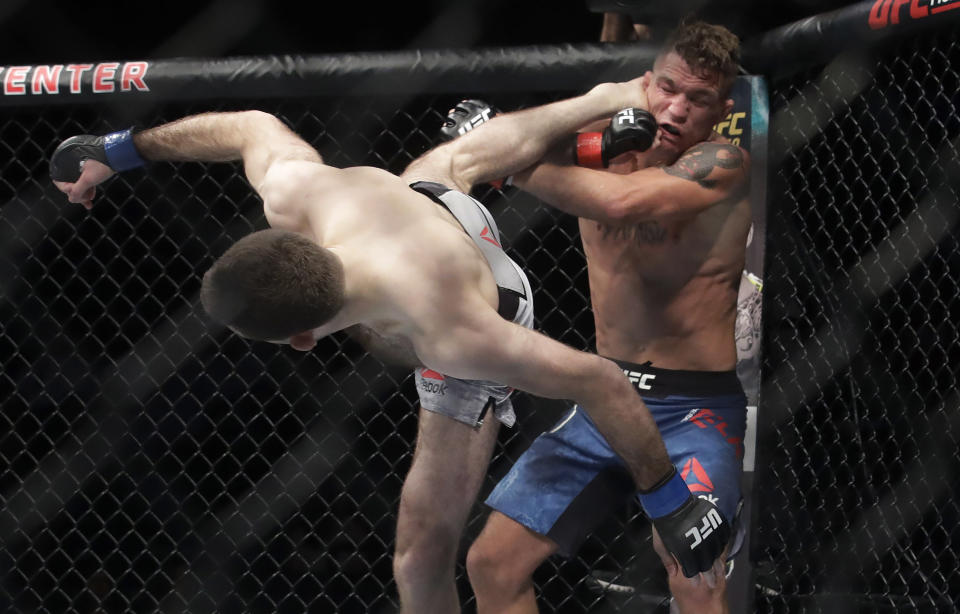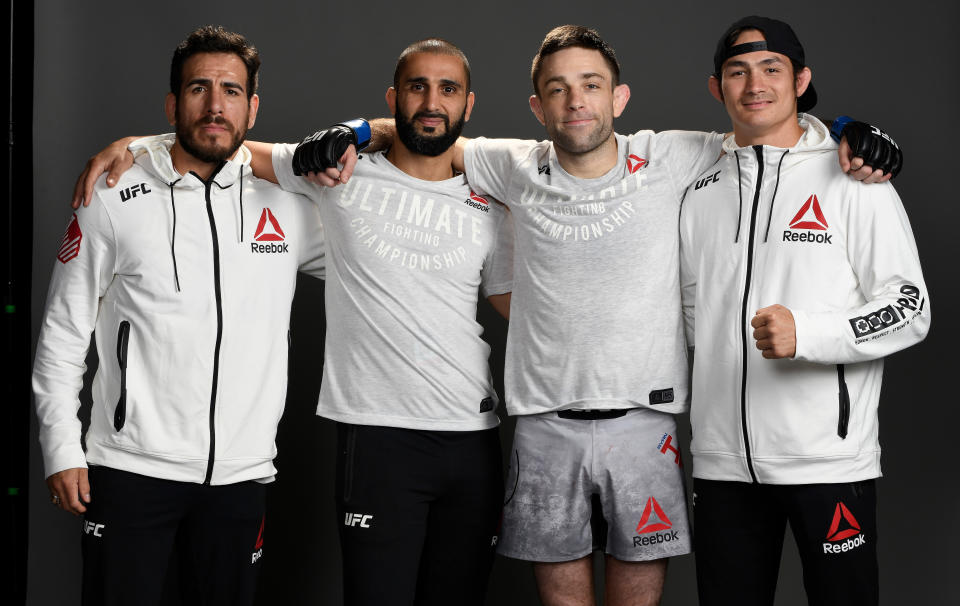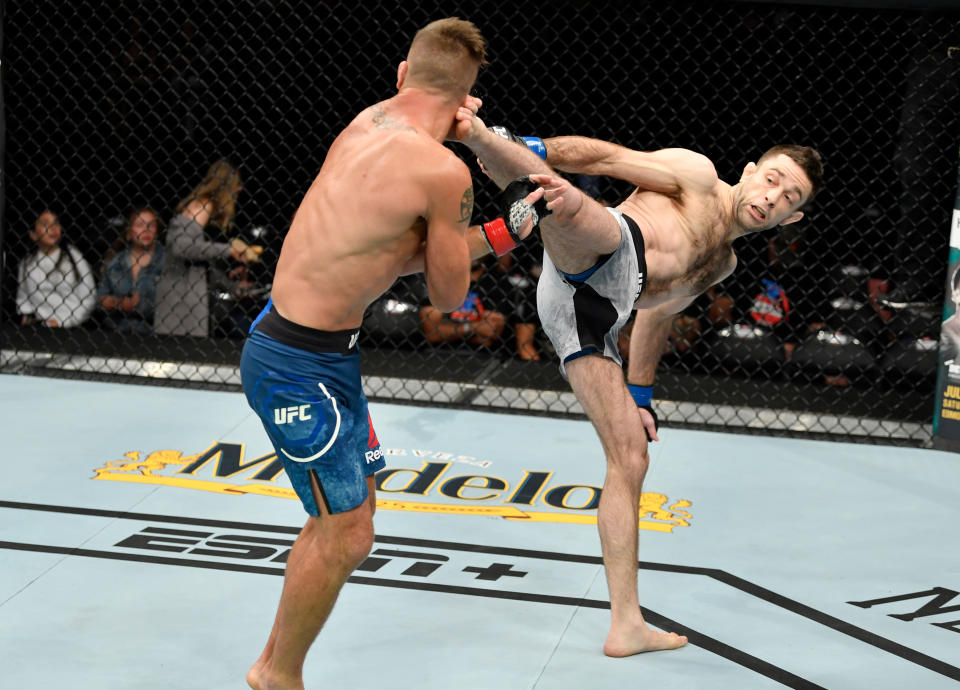Uniquely focused: In the gym with UFC contender Ryan 'The Wizard' Hall

Ryan Hall did a lot of impressive things Saturday night at UFC Sacramento, and made them look easy. He hit takedowns, hit sweeps, landed hard left punches, and dropped Darren Elkins three times in the first two rounds.
The latter two were well-timed and placed left hands to the head. The first knockdown for Hall came from a spinning high kick.
Given that the elite Brazilian Jiu-Jitsu competitor is known for his ground prowess, his effective and powerful striking against Elkins might have surprised many. To be fair, Hall outscoring opponents on the feet isn’t exactly new, though he certainly goes about it with a different tempo and angles not used by many others.
Still, knocking down one of the most well-conditioned and tough competitors at featherweight three times in a single fight, and on the strength of many flamboyantly technical spinning kicks no less, was impressive enough to surprise just about any onlooker. If it weren’t for what I witnessed firsthand this past February at Hall’s 50/50 Martial Arts Academy, I might have been more shocked myself.

Hall: ‘I don’t take vacations’
When I spoke with Hall last September, looking ahead to his December 2018 fight with BJ Penn, he detailed his constant, busy approach to training. Hall insisted that he didn’t fight for the money — he and his fellow black-belt wife Jenn’s academy in Falls Church, Virginia, was the source of their regular income — but simply because he has “the skill and desire to do it.”
So, Hall was intent on taking the time between fights to actually add to his skill set. Then, after becoming a better, more well-rounded martial artist and fighter, he looked to book fights and plan training camps, during which specific tactics could be developed for an opponent and his timing and conditioning could get sharpened.
The two years between his win over Gray Maynard in 2016 and his engagement with Penn in late 2018 was certainly more time than Hall had planned for or wanted — that lay-off length was due to people turning down fights he’d accepted, Hall said — but at the very least he was confident that the world would certainly see an improved fighter given that he’d been working on himself almost nonstop for several years behind the scenes.
this was pretty slick #UFC232 pic.twitter.com/WbnsFObIp4
— Joey Oddessa 🇨🇷 (@MMAOdds) December 30, 2018
Hall went on to quickly submit the legendary Penn. Six weeks later, I traveled with my friend and Foundation Chicago team member Ramy Daoud to train at the Hall’s 50/50 academy and we witnessed just how serious the TUF winner is about this whole no offseason thing.
What we found was a man with a system and team dedicated to breaking down fighting to its elements, moves down to their minutiae, and then drilling them ceaselessly. We caught a glimpse of the ways Hall doesn’t let anything stand in the way of his training – not running a gym and teaching there daily, not his growing family including a newborn baby, not even injuries and health concerns. We saw just how seriously Hall takes his training and how he uses every opportunity to train.
Shortly before we arrived in the Metro D.C. area to train at 50/50, Hall had made a training trip to work with elite kickboxer Raymond Daniels. While we were there several pros also visited Hall, as did 2020 Olympic hopefuls and members of the national Canadian wrestling team twin brothers Thomas and Phillip Barreiro.
Hall spent hours training with them all, drilling and asking questions like a student. The week after we were set to leave Hall’s friend, coach and former three-time world title-challenger Kenny Florian visited and conducted his own seminar, giving Ryan another opportunity to learn.
Mere weeks after scoring the biggest win of his career, and with no subsequent bout yet signed, Hall was already full-swing back in training when we arrived in mid-February. As far as we could tell, he’d been in that mode for some time already.
Let nothing stand in the way of training
Soon after warming up on Feb. 14, Hall began teaching with us group of students sitting in a circle around him on the blue mats. On the agenda was open-guard passing. A few minutes into Hall’s teaching I noticed a light blue glove on one of his hands.
As his wife Jen later explained, a car hood had recently slammed Hall on his hand, cutting it badly. Despite the injury, he continued to train. As a result, the hand then became infected with staph. Hall was now on antibiotics and not at all contagious, and so he was back on the mats teaching, with a few millimeters of latex supposedly protecting his hand.
The class progressed, with Hall pausing it periodically to demonstrate and explain next steps to the passing sequence. He also encouraged questions from students and checked in on everyone’s comprehension multiple times within each explanation asking, “Does that make sense?,” then saying, “Great!,” before moving on.
Before long, first-degree BJJ black belt Jen Hall walked in with their newborn son and partitioned a small ring out for him to play on the mat as class continued. After technique and drilling, students sparred with one another.

As great classes often do, this one went late. After class, I came back out to the floor to say goodbye to the Halls. Jen and baby Hall were now centered up on the mats, near Ryan, who was gloved-up and beginning to hit pads held by fellow TUF veteran, 50/50 instructor and now ONE Championship fighter Thanh Le.
Le was back at 50/50 from his home of Louisiana and was a couple months away from winning his ONE debut by knockout. The fifth degree Taekwondo black belt is a skilled striker and striking coach and Hall wanted to take advantage of his presence to get more work in, even though it was well past 9 p.m. and with baby in tow.
💥 WHAT. A. KNOCKOUT! 💥
Thanh Le makes a massive statement in his ONE debut, stopping Yusup Saadulaev at 0:12 of Round 2! 🤯 @ThanhLeMMA #WeAreONE #ForHonor #Jakarta #MartialArts pic.twitter.com/RmR2b29VbR— ONE Championship (@ONEChampionship) May 3, 2019
The next day at the academy I asked Ryan how long he and Le worked out for after everyone else had left. “Just about an hour and a half,” he shrugged, nonchalantly.
Technique over everything
Ramy and I took that morning’s Jiu-Jitsu class and then stuck around for the Pro MMA practice. Pro MMA fighter and 50/50 striking coach Carlos Vera partnered with us, working largely on ground sparring with strikes.
Hall and Le paired up and worked on one sequence on the ground, with several offshoots, the entire time. For over an hour Hall drilled repetition after repetition with Le.
It was clear there was one thing he wanted to work on in practice, and Hall did so diligently, without any real rest, nor apparent break in focus. The sequence he drilled with Le wasn’t fancy, but they repped it with intention over and over, discussing tweaks and then making those adjustments in additional reps.
That night we returned once more for kickboxing sparring and joined Hall, Le, Vera, and Da’Mon Blackshear, another MMA pro visiting from North Carolina. Hall led and took part in the sparring session.
He structured it in a unique way. With no one on the mats in an actual training camp with a specific fight date looming, Hall designed the sparring to focus more heavily on technique and the conditions to use it.
He set the timer for short rounds with long rest in between to encourage a focus on technique. It isn’t uncommon for pro fighters to spar only during training camp.
Once in camp they work on speed, timing, intensity, tactics and conditioning. Hall’s approach allows him and his fighters to work on the timing and speed one gets from sparring, year-round, which in turn improves their overall technical sharpness.
Those evening’s rounds began as jab sparring, where each of us could only engage one another offensively with jabs. As the rounds progressed that day and the following day during Saturday sparring, Hall then allowed us to slowly expand our arsenal to lead punch sparring, where we were allowed to only use our lead hands, but with any punches we desired: jabs, hooks, uppercuts.
Then, we moved on to lead-side sparring, where we were allowed to use any weapons from our lead side, whether they be punches, knees or kicks, and we were permitted to switch stances. The progression and expansion of allowable sparring was deliberate and done over those two days.

Oftentimes during sparring we, for better or worse, simply go with whatever tools and tactics we are most comfortable with. Sometimes that means making the same mistakes over and over, relatively unexamined.
Sometimes that means always fighting to one’s strength and, even when finding success in sparring rounds, never working to develop new skills or turn weaknesses into strengths. The wide-open availability of weapons in MMA contribute to this, as does the stress, intensity and speed of sparring.
You also get very tired in MMA and striking sparring — more so than when you’re just working on individual elements of the fight. This, along with the aforementioned intensity, speed and wide array of options can sometimes lead to sloppiness in sparring.
Sloppy sparring will mean sloppy fighting. With the decreased round lengths and increased rest time in Hall’s out of camp sparring structure that week, however, I found myself being more intentional and working on being more precise with my technique.
Simply put, I wasn’t just winging it out of exhaustion, and I had more time in between rounds to think about possible adjustments to make in the next session with my partner. I suddenly, after 20 years of training, had my eyes opened up to possibilities sparring could offer for technical improvement, if only broken down in this way from time to time.
The next day, after another long kickboxing sparring session, the Barreiro twins conducted a wrestling seminar for the academy. The two former American University team members were just a few weeks away from winning their third and fourth Canadian National Titles in Greco-Roman wrestling, respectively.
Hall jumped into the seminar, which lasted over two hours, and worked with 50/50 instructor and team member David Terao. Terao, an NCAA Division I All-American wrestler, judo black belt and BJJ purple belt, wrestled with the Barreiro brothers in college.
Hall drilled everything shown by the Barreiros and asked them and Terao lots of questions in between. The generous Barreiros taught longer than scheduled and by the end of the seminar, Hall had been on the mats for over four hours.
Still, he stayed over an hour longer after students had left to work more with the Barreiro twins, who went over more technique but also asked Terao and Hall to teach them the rolling inversion “The Wizard” had used to wrap up BJ Penn’s leg.
The Barreiros are focused on making it to the 2020 Olympics, but are also curious and open-minded martial artists who do Brazilian Jiu-Jitsu rolling from time to time when visiting Montreal’s Tristar Gym to train with their coach Doug Yeats.
High-level learners and athletes, both, the barrel-chested brothers were able to learn and apply the mechanics of the inverted roll within minutes of it being explained to them with just a bit of practice.

After the long, productive day of training we were invited to dinner. While getting ready, I heard a loud thud coming through the halls over and over.
I assumed Hall and his team were moving equipment around the academy for some reason. When I came out of the locker room I discovered that Hall was alone on the mats, kicking a free-standing heavy bag shaped like a man’s torso.
Hall kicked without speaking, over and again. I sat down on the mats near him and watched.
The rhythmic booming of his leg hitting the head of the bag dummy every few seconds was the only real thing heard in the now virtually empty academy. After every student had left, and as the sun outside set on a full day of training for him that had begun in the morning, Ryan Hall performed one single kick, over and over.
To my eye, each kick looked and sounded good. Hall shuffled deftly to close distance, chambered his kick nicely, snapped it out and retracted it with great balance. It was the same kick over and over, executed pretty much identically each time. There was no timer, Hall took no breaks.
Just that one high kick again and again, each time rocking the dummy backward. I looked at the clock and saw it roll past when I was told we were going to eat, and had no real idea when this final, lone training session would end for Hall.
I certainly wasn’t about to interrupt him and ask. Minute after minute, kick after kick, soon it had been well over a half hour of Hall rinsing and repeating.
Still, he kicked on. With no round timer I didn’t know what his goal was.
The high kick was not dissimilar to the ones he would go on to use against and hurt Elkins in Sacramento, months later. He even combined it with level-changes into takedown and guard-pulling motions on the dummy as he successfully does in bouts.
So far, in his UFC career, Hall has proved a riddle to opponents. He fights completely different than anyone they’d ever faced, threatening from positions and angles that no one has ever endangered them from.
This, it turns out, is not an accident. What may look like flippantly thrown kicks, and bizarre distance-closing maneuvers in fights, are actually all custom-fit techniques and tactics that Hall spends hours honing in the gym.
That’s why they work for him.
The bag dummy rocked and rocked from the impact of Hall’s kicks.
Then, the bag fell, snapped backward and landed hard after being hit by Hall. “Ahh,” he said, breaking his silence.
“That’s it. I’ve been trying to figure out what I was doing wrong and why it wouldn’t go down.”
Hall had solved a technical puzzle only he knew he’d been working on. He did so in a manner I’d come to realize was entirely typical of him – Identify the problem, come up with an idea to solve it, and practice until it’s fixed, no matter how long that takes.
More from Yahoo Sports:

